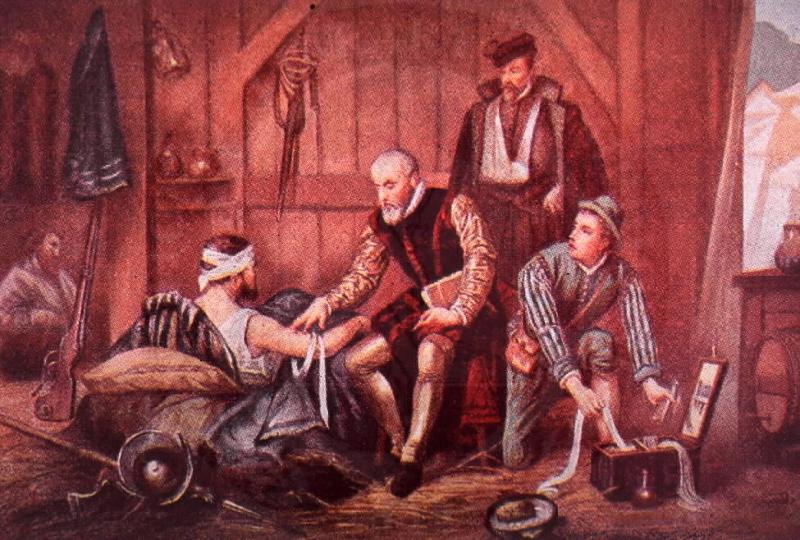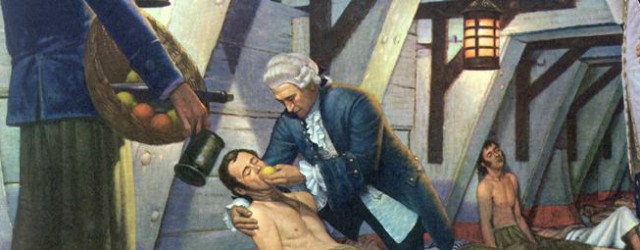Learning Objectives
After successfully completing this section, the student will be able to:
- Define what "human research" is and how to identify it
- Define "equipoise" and discuss its relevance to decisions about whether clinical trials are ethical
- Explain what is meant by "informed consent"
The Origins of Intervention Studies
History is dotted with episodes in which comparisons of outcomes among groups were used to demonstrate the effectiveness of new treatments. Sometimes these were accidental experiments. Ambrose Pare was a French barber-surgeon who was a keen observer and innovator, and is regarded as the father of surgery by some. At the age of 26 (1537) he was serving in the French army in northern Italy, but he was relatively inexperienced with battlefield wounds. Pare described the aftermath of a battle:
|
"... many of our soldiers were killed or wounded by lance and shot, keeping the surgeons busy. At that time I was quite inexperienced and had never seen shot wounds treated. Certainly I had read in Jean de Vigo's general work on wounds that the properties of gunpowder made shot wounds poisonous, and that they should be treated with seething elder-oil.... To avoid doing anything crazy, and knowing that this treatment would be very painful to the victims, I decided to wait until I had seen what the other surgeons did. They actually made the oil as hot as possible and dabbed it on the wound. I then took heart and did the same, But my oil ran out, and I had to apply a healing salve made of egg white, rose oil, and turpentine. The next night I slept badly, plagued by the thought that I would find the men dead whose wounds I had failed to burn, so I got up early to visit them. To my great surprise, those treated with salve felt little pain, showed no inflammation or swelling, and had passed the night rather calmly - while the ones on which seething oil had been used lay in high fever with aches, swelling and inflammation around the wounds. At this, I resolved never again to cruelly burn poor people who had suffered shot wounds."
|
:
Scurvy, caused by a deficiency in vitamin C, was an enormous problem for sailors during the age of exploration. Collagen is a protein that plays an important structural role in all tissues. Humans require vitamin C from fruits and vegetables in order to cross-link collagen fibers to provide normal tissue strength. If vitamin C is deficient for long periods, such as sea voyages, tissues are weakened, and there is a tendency for capillaries to rupture easily causing bruising and bleeding with slight trauma. Severe scurvy is manifest by bleeding gums, bleeding into joints, severe anemia, and eventually cardiovascular failure and death. Commodore George Anson led a famous circumnavigation from 1740-44. He left England with seven ships and 1,955 men with the mission of harassing the Spanish fleet in the Pacific off Central and South America. He returned with one ship and 145 men. In total 1,051 sailors had died, mostly from scurvy. The East India Company had noted scurvy was common among the sailors on their ships, but one ship that carried lemons had remarkably been spared. Nevertheless, it wasn't until 1747 that James Lind, a Scottish surgeon in the British navy, designed an experiment with a purposely designated "control."

Lind selected 12 sailors suffering from scurvy and treated them in pairs with one of several 'treatments': cider; seawater; a mixture of garlic, mustard and horseradish; vinegar; or oranges and lemons. Those fed citrus fruits recovered quickly, while the others remained ill. While earlier observations had suggested the efficacy of citrus fruits, Lind's experiment established the superiority of citrus fruits over other treatments.
Another famous predecessor of modern intervention studies was Edward Jenner's experiments on the efficacy of vaccination to prevent smallpox. Smallpox had been a scourge of mankind for centuries. It had a high case fatality rate and even the survivors were left with horrible aftereffects such as blindness and disfigurement from scarring. The practice of inoculation or 'variolation' seems to have originated in Africa, India, and China, but wasn't introduced to Europe until the early 1700s by Lady Mary Wortley Montagu.
and even the survivors were left with horrible aftereffects such as blindness and disfigurement from scarring. The practice of inoculation or 'variolation' seems to have originated in Africa, India, and China, but wasn't introduced to Europe until the early 1700s by Lady Mary Wortley Montagu.
Edward Jenner had heard that dairymaids were protected from smallpox after they had contracted cowpox, a related infection. In 1796 Jenner took material from a young dairymaid's fresh cowpox lesions and used it to inoculate an 8-year-old boy, James Phipps. Phipps developed a mild fever, soreness in his armpits, and loss of appetite, but recovered about a week later. About two months later, Jenner inoculated the boy with fresh smallpox pus, but he did not become ill, and Jenner concluded that the cowpox "vaccination" had protected the boy against smallpox. While this is regarded as a landmark event in the prevent of infectious disease, one should question the ethics of conducting this experiment.
Link to article: Edward Jenner and the History of Smallpox Vaccination



